George David Black Jr. was born to George David Black Sr. and Mary McRee Black. Mary McRee was born October 17, 1819 Copiah County, Mississippi, the daughter of William McRee [or McRae or McCree] and Mary McCorkins McRee. Her parents were of Scotch descent and had immigrated to Mississippi from North Carolina about 1816. William was a wealthy planter and doctor of medicine of high standing.
In 1841 Mary McRee and her husband joined the Mormon Church, having been converted to the faith by Daniel Tyler.
Around 1845 Mary and her husband moved to Nauvoo. When they joined the Church her father told her she was being led astray by the devil, so when they left for Nauvoo they gave up family, friends and their land and property which they could not dispose of. Mary had a half section of valuable timberland that her father had given her as a "gift of love" at the time of her marriage. This was later sold for taxes.
After arriving in Nauvoo, Charles worked on the Nauvoo Temple for two years, and later engaged in the mercantile business. He took a partner in with him and was successful until his health failed him. He died of malaria in 1845. The partner of Mr. Black, a Mr. Guily, defrauded Mary of every cent that was invested in the business. He was afterwards excommunicated from the Church.
Mary became very ill, and the doctors told her she would go as her husband had unless she went away from that climate. Mary refused to go but sent for the Prophet Joseph and he brought Brigham Young with, and blessed her, and told her to go home to her husband’s people until spring. They told her she would recover and would live to do much good.
She took the advice of the Prophet and went back to Mississippi. While there, she made peace with her father who felt more favorable towards his daughter. Her stepmother who had always been so good to her, stood by her in her trials, as she was called upon to give up her last little daughter leaving her with one little son five years old. During all this time her brothers and sisters ignored her.
In the spring Daniel Tyler with others of the Saints in Mississippi took Mary and her little boy, George David Black Jr., back to Nauvoo. Mary took this child to Brigham Young and told him that this was the only child she had left and she did not want to lose him. Their family history stated that Brigham Young took the little boy down to the Mississippi River and baptized him, then sealed him up against all sickness and disease. He came on to Utah with Captain James Brown and lived in Ogden, Utah. George David Black was later asked to help colonize the area of Oxford, Idaho. He married and had thirteen children, but never had a sick day in his life. He was killed in a wagon accident in 1913.
At Council Bluffs, David's stepfather Captain James Brown enlisted in the Mormon Battalion as Captain of Company "C". Before he left, on July 16, 1846, he married Mary McCree [McRee] Black. Mary became one of the laundresses for the Battalion and took her son, George David Black, with her.
George David Black, married his childhood sweetheart, Mary Hunt on February [Pauline Smith wrote: September] 16, 1861 in Ogden, Weber County, Utah a year after the move to Ogden. Mary and George David had been children together during the winter in Pueblo, 1846-1847, and in the old fort at Salt Lake. David was the stepson of Captain James Brown, of whom Jefferson thought highly." --Pauline Udall Smith, page 195 Mary Hunt was born on July 12, 1845 at Bear Creek, Nauvoo, Hancock County, Illinois to Captain Charles Jefferson Hunt and Celia Mounts Hunt. Mary and her twin brother, Parley Hunt, were their tenth and eleventh children. Parley died on January 1, 1847 at Pueblo, Pueblo County, Colorado. Mary and Parley lay side by side as the wagon wheels turned round on the long trek across Iowa, on to Santa Fe, and from there to Pueblo, where Parley succumbed to the rigors of weather and travel. In her home in the wagon train, in the forts in Salt Lake and Provo, she was a joy to all.
Mary attended her first school in San Bernardino, California. At the age of thirteen she was again in Utah, first in Parowan, Iron County, and from there to Ogden, Weber County, where she met and later married David George Black. They made their home in Ogden with frequent visits to her father's home in Huntsville, fifteen miles up lovely Weber Canyon. They lived in Oxford, Bannock County, Idaho ten years where she gave love and attentions to her beloved father during the last eight years of his life.
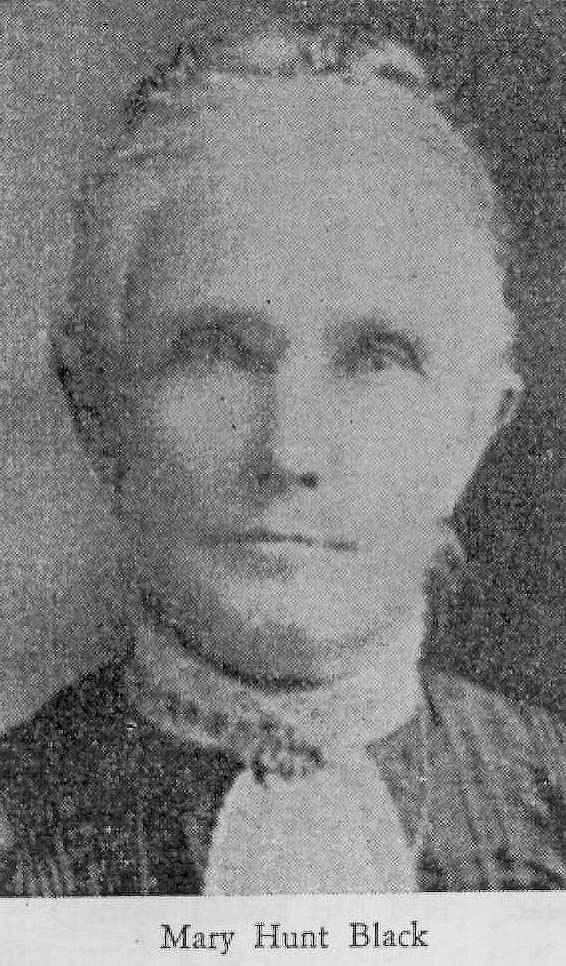
Mary Hunt Black 1845-1930
Captain Jefferson was in frequent demand for patriotic orations. He usually stayed with Celia and the Blacks. David was a hard worker but he was also familiar with music and schooling. His mother was an educated woman from the south. He played the snare drum in the first Marshall band in Ogden. He was also a fine violinist and played for dances. He was the official town cannon shooter, which was fired on special occasions. As he grew older he lost his hearing as a result.
Their marriage had been a happy occasion for everyone. Jefferson gave them a wedding present of a hundred dollars worth of merchandise, considered a large amount in those meager days. Their first two babies died early in infancy, and Celia sought to comfort them in their heartache.
While Captain Jefferson and Celia traveled to California during 1864, David and Mary remained in the Hunt home in Ogden.
David and Mary lived in Ogden until 1871 when he moved his family to Huntsville, and the following spring they moved to Oxford, Idaho. David ran large herds of cattle out on Promontory and was considered a fine judge of cattle.
George and Mary Black's home was one of culture and hospitality, he with the violin, she with her homemaking gifts and grace made it the center of the community social life. They wee ever active in the Church positions; they shared generously with the needy, and were peacemakers with the Indians. They kept young in spirit and filled with vigor to the end of their long and useful lives.
While living in the Oxford Branch he was made Presiding Elder for three years and then was made first counselor to Bishop Fisher. He also served as Justice of the Peace. They lived in Oxford until they were called in 1883 by church authorities to help build up the area around the Snake River Valley in Idaho, near Wilford and Rexburg, Idaho. George served on the High Council, was Sunday School Superintendent and a Lieutenant in the Utah Militia. The Snake River Valley became their last and permanent home. Enjoying fifty-two years of marriage, here they are buried.

FIFTY YEAR ANNIVERSARY - PIONEER JUBILEE MEDAL
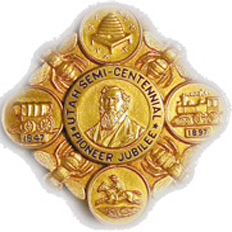
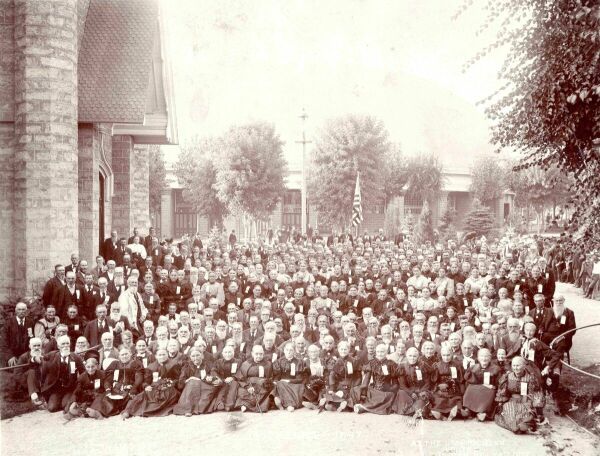
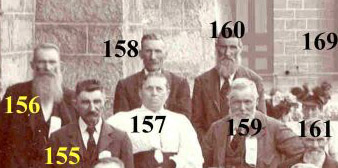
George David Black in the 1897 George Anderson photo of the original 1847 Pioneers taken at Temple Square in SLC.
He is Number 158. Who is around him? Number 157 is his wife Mary Luella Hunt Black. Number 123 is his mother, Mary McRee Black Brown.
See at: http://www.dupinternational.org/jubilee/pioneersnumbered.htm

He was a real friend to the Indians. His trade was carpenter and plasterer and he helped build many buildings. In 1903 he moved his family to Oregon, but soon returned to Idaho.
In 1913 he fell from a wagon and was badly injured and died five days later, 71 years of age. Before he died he told friends to tell his children to always stay true to the church. He was a firm believer in the gospel, a devoted husband, father, and friend.
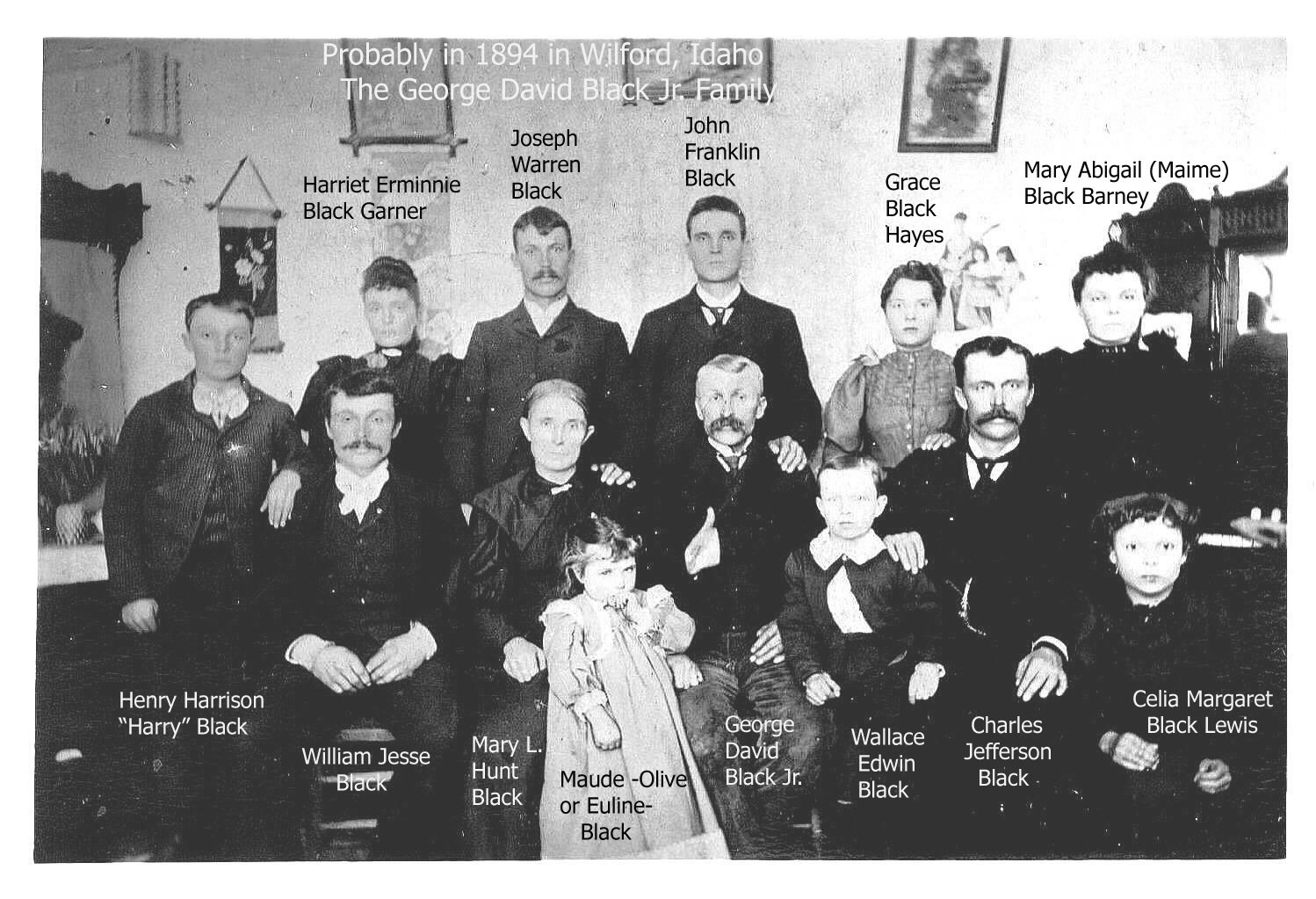
Many thanks to cousin Stan Radford of Sandy, Utah. for contributing this photo.

Children of George David Black and Mary Hunt Black's Children:
1

Nancy Jane Black
Born: 22 January 1863 at Ogden, Weber, Utah
Child
Died: 11 June 1865 or 1866 at Ogden, Weber, Utah

|
2

George David Black, III.
Born: 24 October 1864
Child
Died: 17 February 1867 at Ogden, Weber, Utah

|
3

Charles Jefferson Black
Born: 24 November 1866 at Ogden, Weber, Utah
Married: Alice Malona Pratt on 18 January 1890 (D); md. (2) Mary Ann Steers on 22 January 1896
Died: 18 May 1928 at Legrande, Union, Oregon

|
4

William Jesse Black
Born: 16 March 1869 at Ogden, Weber, Utah
Married: Sarah Elva Jacobs on 13 June 1892 at Logan, Cache, Utah
Died: 25 July 1947 at Burley, Cassia, Idaho

|
5

Harriet Erminnie Black
Born: 21 April 1871 at Huntsville,Weber, Utah
Married: Frederick William Garner on 18 June 1891 at Logan, Cache, Utah
Died: 6 Nov 1969 at Idaho Falls, Bonneville, Idaho

|
6

Joseph Warren Black
Born: 28 May 1873 at Oxford, Franklin, Idaho
Married: Sarah Ann Stewart on 20 July 1899 at Logan, Cache, Utah
Died: 22 October 1954 at Salt Lake City, Salt Lake, Utah

|
7

John Franklin Black
Born: 28 May 1875 at Oxford, Franklin, Idaho
Married: Mattie Pratt (D); md (2) Alice Maude Raybould on 15 June 1899; md (3) Mary Jane Pinckard
Died: 1958 at Boise, Ada, Idaho

|
8

Mary Abigail Black
Born: 21 March 1878 at Oxford, Franklin, Idaho
Married: William Warren Barney on 19 April 1911 at Logan, Cache, Utah
Died: 31 March 1939 at St. Anthony, Fremont, Idaho

|
9

Grace Black
Born: 20 May 1880 at Oxford, Franklin, Idaho
Married: Fredrick Richard Hayes on 22 November 1901
Died: 1 September 1904 at Sugar City, Madison, Idaho

|
10

Henry Harrison Black
Born: 22 February 1882 at Oxford, Franklin, Idaho
Married: Mary Lydia Birch on 23 July 1903 at Wilford, Fremont, Idaho
Died: 7 May 1951 at West Yellowstone, Gallatin, Montana

|
11

Celia Margaret Black
Born: 14 November 1884 at Wilford, Fremont, Idaho
Married: Leroy Clarence Lewis on 14 January 1903 (D); md (2) William Hansen on 12 September 1959
Died: 1956 at St. Anthony, Fremont, Idaho

|
12

Wallace Edwin Black
Born: 12 December 1885 at Wilford, Fremont, Idaho
Married: Emma Harris on 12 December 1918 at Pocatello, Bannock, Idaho
Died: 16 Dec 1924 or 1927 at Los Angeles, Los Angeles, California

|
 |
13

Maude Olive Black
Born: 21 September 1890 at Wilford, Fremont, Idaho
Child
Died: 28 March 1899 at Wilford, Fremont, Idaho

|

|

MARY MCREE BLACK BROWN, WIFE OF CAPTAIN JAMES BROWN
[Also a Biography of George David Black and Family]
by her son George David Black Jr. and his wife, Mary Hunt Black
and their daughter Harriet Erminnie "Minnie" Black Garner
Among those who received the message of Mormonism in the beautiful valley of the Mississippi were George and Mary McCree (sp) Black who was born in Copiah County, Mississippi. They were baptized in 1841 by Daniel Tyler and that same year, George David Black Jr., was born February 18th. The father died of malaria in 1845. After his death Mary lost two little girls with the same disease within two months. The shock was so great that she became very ill and the doctor told her that if she did not go to a warmer climate she, also would die.
During this time of sorrow she sent for Brigham Young. He answered her request bringing with him James Brown. They blessed her and told her to return to her home where she could be with her own people. She took with her the two remaing daughters and son, George David, and went to the home of her husband's people who had become Mormon converts. Again the angel of death visited her and took both of her little girls.
In the spring she returned with missionaries to Nauvoo. Shortly after George David was stricken with malaria and fearing that he, too, would die she sent for Brigham Young to come and administer to him. Brigham came as quickly as possible. "Mary," he said, "I will take him down to the Mississippi River and baptize him for his health." The boy recovered and was made well and strong again.
When the Saints were driven out of Illinois and companies were being formed to go west, James Brown invited Mary and her son to go with the company. This she was glad to do, joining the trains of snow-covered wagons in almost countless numbers that poured of Nauvoo. After reacing Council Bluffs, Iowa, James Brown proposed marriage to Mary. She accepted and they were married at that place.
When James was made Captain of Company D [Company C] of the Mormon Battalion he took Mary and George David with him on the long journey where they endured untold suffering. Mary cooked and washed for the men. Little David was her joy and consolation during these trying months. Sfter reaching Santa Fe, New Mexico, Captain Brown was detailed to take the women, children and disable soldiers to Pueblo, Colorado where they wintered. In the spring of 1847, they, with other members of the company, again took up the long journey to the valley, arriving in Salt Lake City July 29, 1847.
George David and Mary went north with Captain Brown when he was called to buy and colonize a tract of land on the present site of Ogden bought from Miles Goodyear, an ole trapper with an Indian wife. Mary lived in the log cabin with a dirt floor and the only furniture was a one-legged bed nailed to the wall. When she saw her new home forty miles from a neighbor, she exclaimed, "This is a hard way to serve the Lord." In this community she later became known as an outstanding cheesemaker. She lived to be eighty-six years of age and died a faithful Latter-day Saint.
David grew to manhood and worked many hours on the land. His education was rather meger, but his mother being a cultured woman had taught him to read from the Bible and tried to instill into his young life the wound and lasting principles which would remain with him throughout his mortal exisence. He was baptized and ordained a deacon in 1851.
While the mothers cooked meals over campfires during the sojourn with the Battalion, David often played with Mary, daughter of Captain Charles Jefferson Hunt. After the Mormon Battalion was mustered out and Captain Hunt returned to Utah, he and others, were called to colonize the San Bernardino Valley in California. Thus the children were separated until May was about fourteen years of age when her father and his family were called back to Utah on account of Johnston's Army. The Hunt family located in Ogden. Mary was then a beautiful blue-eyed, dark-haired girl. During all the years, David had retained a love for his childhood sweetheart. When he met her again he vowed that no other man should call her wife. Mary returned his love and they were married September 16, 1861 at the home of Captain Hunt, the ceremony was performed by Joseph A. West, the first bishop of Ogden. Later they were sealed in the Endowment House in Salt Lake City.
The young couple made their home in Ogden untl 1871, where four chlildren were born to them: Nancy Jane Black, George David Black Jr., Charles Jefferson Black, and William Jesse Black. During this time the father took care of large herds of cattle out on Promontory. John Henry Smith also herded cattle in this vicinity and they became staunch friends. George David was a member of the first martial band of Ogden, playing snare drum and he was also a good violinist, playing for the town dances. He was honored as the official cannon shooter of the city. During a 4th of July celebration, while shooting the cannon, he did not get away quickly enough and received a shock which impaired his hearing for the rest of his life.
In the fall of 1871, George David moved his family to Huntsville. The snow fell so deep that winter it covered the little dugouts in which many of the people lived. David and Mary lived in a one-room log cabin and here on April 21, 1872, Harriet Erminnie Black was born. In March of the next year they were on the move again, settling in Oxford, Idaho, and here they stayed for eleven years. During this time five more children, Joseph Warren Black, John Franklin Black, Mary Abigail Black, Grace Black, and Henry Harrison Black came to bless their home. In 1874, George David was ordained an Elder by John Boice and, in 1875, was made Presiding Elder over the Oxford Branch, Cache Stake of Zion. He held that position for three years and then was chosen first counselor to William F. Fisher who was called from Richmond to be Bishop of the Oxford Ward. The Black family lived in Oxford until the Upper Snake River Valley was being colonized by the Mormons. George David was called by the President of the Stake, William B. Preston, to go and help build up the valley.
So once more they traveled over mountains and through deep sand, through the Bannock Indian Reservation, then a barren desert with only an Indian agency at Fort Hall. "As we drove through Portneuf we children expected every moment a band of Indians would come rushing out of some of those ravines. Finally we reached the great Snake RIver, and crossed the old toll bridge at Eagle Rock, then on to Market Lake. How the old wagon jolted over the lava beds. There were no roads, just a trail to follow. Again we reached the river north of Rexbury. When we found out we must ford the wide deep stream, our hearts almost failed us, but we had come to build a new home and knew that was the only way we could get to it. Father told us not to be afraid. We offered up a prayer to our Heavenly Father, then fater drove into the stream following the sand bar. How happy we were when we reached the opposite side of the mighty river, and reached our lone log cabin near the banks of the north Teton River, November 6, 1883.
"The snow fell that night and we never saw the bare ground again until the first of May. It was a long hard winter. There were no amusements of any kind. Neighbors had to travel back and forth on snowshoes. The older people visited with each other and read a few books they had brought with them, while the children played games and amused themselves as only children can. In March Thomas E. Ricks came from Rexburg and partly organized a Sunday School so we might have something of a spiritual nature."
As Christmas time came near, the younger children began to talk of Santa Claus which made George David and Mary very sad as seventy-five cents was the total sum of money in the house. They talked it over and decided that the children would have a little candy at least. He would drive to Rexburg, a distance of seven and one-half miles. The day before Christmas a raging blizzard came, but David hitched his horses onto an old homemade sleigh and started out. He had to ford two rivers before he reached Rexburg. At the first, the Teton, the horses broke through the ice, plunging into the icy water. David somehow got hold of the horses bridles and got them back on the bank. It was several hours later when he reached home nearly frozen. Mary, although disappointed that the children would not receive even the candy, was truly thankful that her husband was safe at home again and late that night she made a little candy of the precious sugar on hand and parched som corn. With the help of the older daughter, Minnie, she made rag dolls for the little girls using charcoal to make the hair and eyes and fruit juices to paint their cheeks. The children were overjoyed with their gifts and it can truly be said that this was one of the happiest Christmases spent by the family, for every heart in that humble home was in tune.
The spring found George David busy plowing and planting his precious seed. Along with his other duties he became superintendent of the Wilford Sunday School. He was also presiding Elder of the Wilford Branch. When the bannock Stake of Zion was organized he was chosen a member of the First High Council, and was the senior member. He often walked a distance of twelve miles to attend quorum meetings.
George David was a true friend of the Indians and learned their language. They taught him to hunt and fish and were often amazed when he caught the biggest fish. They named him "Pigga Panguitch" meaning "big fish". After forty years he went to Salt Lake City to attend the Fiftieth Anniversary of the Saints arrival in the Valley. Heree he saw an old Indian woman he had known as the young mother of one of his playmates. He stepped up to her and said, "Loanna" in her language. She was now almost blind. When she recognixed him she cried, "Pigga Panguitch", tears streaming down her face. Members of her tribe had been fed in his home and many would have given their life for him.
George David and Mary passed through all the trials and hardships incident to pioneering a new country. He filled many positions of trust, helped build new meetinghouses and schoolhouses as he was a carpenter and plasterer by trade. While living in Wilford three more children were born to them, Celia Margaret Black, Wallace Edwin Black, and Maudeline Black, the latter dying [March 28, 1899] when she was eight and a half years of age.
In 1903, George David moved his family to Grande Ronde Valley, settling in LaGrande, Oregon, where his son Jefferson Black was bishop, but they did not stay long for they wanted to be with their loved ones in their old Idaho home. When they returned he built a home at Sugar City but again they moved to Oregon to Mount Glen. They eventually moved back to Wilford where he bought another, and as he said "his last home". On April 2, 1912, while riding home from St. Anthony on a heavily loaded wagon of wheat, he was knocked off by some boys who were scuffling, between the wheels of the wagon and was so badly crushed, he died five days later.
------Minnie Black Garner
Found in "Our Pioneer Heritage -- Women and Children of the Mormon Battalion", pages 481-485.
Submitted to this site by Erold C. Wiscombe

Sources:
PAF - Archer files = Mary McRee + George David Black Sr.> George David Black Jr. : Captain James Brown + (6) Mary McRee.
"History of George David Black Jr. 1841-1913" by his daughter Harriet Erminnie Black Garner.
Many thanks to cousin Stan Radford of Sandy, Utah. for contributing this biography to our website.
Conquerors of the West: Stalwart Mormon Pioneers Vol. I, Edited by Florence C. Youngberg, 1999.
"Captain Jefferson Hunt of the Mormon Battalion," by Pauline Udall Smith, 1958, assisted by Alison Cornish Thorne, Ph.D. The Nicholas G. Morgan, Sr., Foundation, Salt Lake City, UT. Pages 195, 196, 213, 244, 245, 290, 298,
Sons of Utah Pioneers, SLC, UT. Page 306 to 308.
Photos, items in [Brackets] and bold are among items added by Lucy Brown Archer
Copyright 2001 www.OrsonPrattBrown.org
|
|